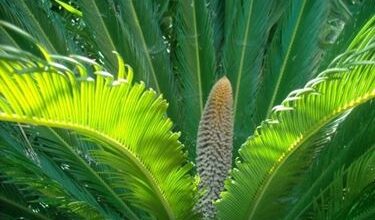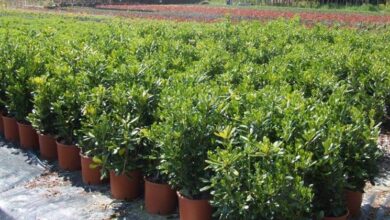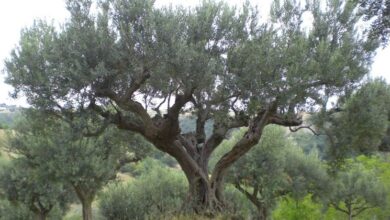Plectranthus

Plectranthus are very beautiful plants, which are used both to decorate the interior of houses and the shady or semi-shaded corners of gardens and patios. Its leaves are usually rounded, green, although there are some that have them variegated.
In any case, its maintenance is not too complicated. In fact, it is easy to find it for example in the houses of our grandparents, growing up with health and strength. So if you also want to have one, below I will explain how Plectranthus are cared for and which are the most popular species.
Origin and characteristics
Our protagonists are herbaceous plants with an annual or perennial cycle, native to tropical Africa, Japan, Australia and some islands in the Pacific. The genus is made up of about 325 accepted species, of the 1000 that have been described. They produce simple, petiolate leaves, with crenate-toothed margins, and inflorescences, usually pedunculated, composed of white or purple bisexual flowers. The fruit is a type of small nut with an ovoid shape, glabrous and with mucilage.
They are usually aromatic and hairy plants, so they are undoubtedly very interesting both for the garden and for growing in pots.
Main species
The most popular species are:
Plectranthus verticillatus

Image – Flickr/ uacescomm
Known as the money plant, it is a species native to Southeast Africa that reaches a height of 10 to 30cm, and with an extension of up to 60cm. Its leaves are serrated, rounded, and measure between 64 to 90mm, with a purple and hairy underside.
It is perennial, which means that it lives for several years.

Related article:Millionaire plant (Plectranthus verticillatus)
Plectranthus amboinicus

image – Wikimedia/ The photographer
Known as French oregano, Spanish thyme, Mexican mint, witchy oregano or Indian borage, it is a perennial plant that grows up to 1 meter in height, with fleshy, rhomboid leaves and a size of 5 to 10 centimeters in length.
It is used in traditional medicine to relieve epileptic seizures, as a disinfectant, antifungal and stimulant; however, several scientific studies (like this one that you can read here ) have found that it is not very safe.
Plectranthus neochilus

Image – Wikimedia/ Krzysztof Ziarnek, Kenraiz
It is an ideal perennial plant as a groundcover that reaches a height of 45 to 60 centimeters, with hairy leaves on the upper side, of a greenish-gray color. Its growth is very fast.
Plectranthus caninus

Image – Wikimedia/ Krzysztof Golik
It is a plant native to East Africa and South Asia that has rounded, green leaves, and produces lilac flowers. It is usually sold as » Coleus canina », to naturally repel both dogs and cats.

Related article:Plectranthus caninus, a plant that smells like lemon
Plectranthus scutellarioides

Image – Flickr/ Puddin Tain
It is known as coleus or chintz, and it is native to both Southeast Asia and Australia. It grows as an evergreen shrub up to 75 centimeters tall and wide. Its leaves are variegated, very ornamental.
Its synonyms Coleus blumei and Solenostemon scutellarioides are still widely used, so you should take it into account if you are interested in buying a copy .
Plectranthus coleoides

Image – Wikimedia/ David J. Stang
Known as frankincense or false incense, it is a herbaceous plant with a sloping, hanging habit that develops bright green leaves with wavy white or cream edges.
Plectranthus barbatus

Image – Wikimedia/ Vinayaraj
Known as Indian boldo, it is a perennial plant native to India that develops leaves with crenate-toothed margins, green in color. Its flowers are a beautiful lilac color.
It is used in traditional medicine for its properties, which are: bronchodilator, soothing, cardioactive, anti-rheumatic, hypotensive and tonic.
How are they cared for?
If you want to have a copy, we recommend you provide the following care:
Location
- Exterior: it must be protected from direct sun. It grows well in shady corners, as long as they are somewhat bright (that is, not full shade).
- Indoor: place in well-lit rooms, away from both cold and warm drafts. Avoid putting it in passage areas as well, because when rubbing past it, its leaves would get damaged.
Earth
- Garden: grows in soils rich in organic matter, with good drainage.
- Pot: fill with mulch mixed with 30% perlite.
Irrigation

Moderated. We must avoid waterlogging, but also drought. Water an average of about 4 times a week in summer, and an average of 2 a week the rest of the year. If in doubt, check the humidity of the soil, either with a stick, or by weighing the pot once it has been watered and again after a few days.
Use rainwater whenever possible, but if you cannot get it and what you have is only calcareous water, mix the juice of half a lemon in 1l of water, and water with it. Don’t wet the leaves, just the earth; and if you have put a plate under it, empty it 30 minutes after watering.
Subscriber
In spring and summer it is highly advisable to fertilize it with organic fertilizers, such as guano following the instructions specified on the packaging.
Multiplication
Although they produce viable seeds, which can be sown in spring in pots with universal growing medium, what is done more is to multiply the Plectranthus by cuttings, also in the flower season.
Healthy chunks are cut, impregnated with homemade rooting agents or rooting hormones, and planted in pots with vermiculite previously moistened with water. They will emit their own roots in two to three weeks.
Plagues and diseases
In very humid environments they can be affected by botrytis, which causes the appearance of gray spots on the leaves. It is treated with fungicide, but the best thing to do is to control watering by avoiding puddling and never wet the aerial part (leaves).
Pruning

They do not need it, although the stems can be pruned a bit in spring if you see that they are growing too much. Use scissors previously disinfected with alcohol to prevent infection, and don’t forget to disinfect them when finished.
Rusticity
They resist cold but not frost. The minimum temperature should not be lower than 5 degrees Celsius.
What uses are they given?
As we have seen, they can be used both as ornamental and medicinal plants, and even as edible vegetables or tubers.
What do you think of these plants? Do you dare to have one?




